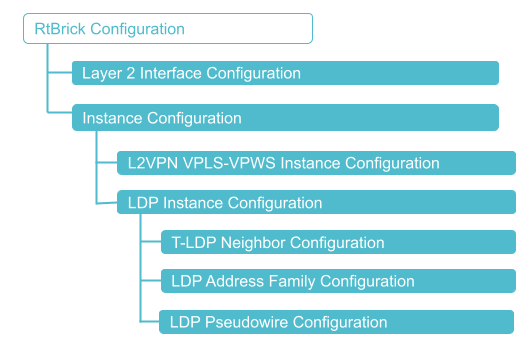Configuring LDP-signaled L2VPN
Configuration Hierarchy
The diagram illustrates the LDP-signaled L2VPN configuration hierarchy. All LDP-signaled L2VPN configurations are done within an instance, such as the default instance or VRF instance.

Configuration Syntax and Commands
The following sections describe the LDP-signaled L2VPN configuration syntax and commands.
Layer 2 Interface Configuration
LDP-signaled L2VPN supports the configuration of Layer 2 logical interfaces.
Syntax:
| Attribute | Description |
|---|---|
|
Specify the name of the interface. Example: ifp-0/0/1. |
|
Create a logical interface (also referred to as a sub-interface) under the physical interface |
|
Specify the type of the L2VPN interface. |
|
Outer VLAN ID. |
|
Inner VLAN ID. |
|
Assign the logical interface to an instance. |
The following example shows a single-tagged interface configuration:
set interface ifp-0/0/17 unit 100 set interface ifp-0/0/17 unit 100 interface-type l2vpn-vpws set interface ifp-0/0/17 unit 100 instance default set interface ifp-0/0/17 unit 100 vlan 100 commit
The following example shows a double-tagged interface configuration:
set interface ifp-0/0/17 unit 200 set interface ifp-0/0/17 unit 200 interface-type l2vpn-vpws set interface ifp-0/0/17 unit 200 instance default set interface ifp-0/0/17 unit 200 vlan 200 set interface ifp-0/0/17 unit 200 inner-vlan 201 commit
Instance Configuration
L2VPN VPLS-VPWS Instance Configuration
This section explains how to enable the L2VPN vpls-vpws address family in the instance.
By default, the SAFI vpls-vpws is disabled, which you should enable for L2VPN Pseudowire.
|
Syntax:
| Attribute | Description |
|---|---|
|
A unique name for the routing instance. |
|
Address family identifier (AFI). Supported value: l2vpn |
|
Subsequent address family identifier (SAFI). Supported values: vpls-vpws The SAFI |
Example: L2VPN VPLS-VPWS Instance Configuration
set instance default address-family l2vpn vpls-vpws
LDP Instance Configuration
LDP Targeted Neighbor Configuration
The targeted neighbor configuration establishes an LDP neighbor with a remote neighbor that is not directly connected.
Syntax:
| Attribute | Description |
|---|---|
|
IPv4 address of the remote LDP neighbor. |
|
Neighbhor address to which ldp hello is sent |
|
Targeted hold time, <0-65535>, default 45s |
|
Targeted hello messages interval, <0-65535>, default 15s |
|
Specifies the neighbor type, that is, sender or receiver. |
|
IPv6 address of the remote LDP neighbor. |
|
Neighbhor address to which ldp hello is sent |
|
Targeted hold time, <0-65535>, default 45s |
|
Targeted hello messages interval, <0-65535>, default 15s |
|
Specifies the neighbor type, that is, sender or receiver. |
set instance default protocol ldp targeted-neighbor ipv4 198.51.100.1 198.51.100.2 set instance default protocol ldp targeted-neighbor ipv4 198.51.100.5 198.51.100.2
Example: LDP Targeted Neighbor Configuration
supervisor@rtbrick>SPINE01: cfg> show config instance default protocol ldp targeted-neighbor
{
"rtbrick-config:targeted-neighbor": {
"ipv4": [
{
"neighbor-address": "198.51.100.1",
"source-address": "198.51.100.2"
},
{
"neighbor-address": "198.51.100.5",
"source-address": "198.51.100.2"
}
]
}
}
LDP Address Family Configuration
The address-family command allows you to enable the address families that LDP will route and configure settings that are specific to that address family.
| By default, the SAFI "vpls-vpws" is disabled, which you should enable for L2VPN Pseudowire. |
Syntax:
| Attribute | Description |
|---|---|
|
Address family identifier (AFI). Supported values: l2vpn |
|
Subsequent address family. Supported values: vpls-vpws |
|
Enable or disable address family. |
Example 1: LDP Address Family Configuration for L2VPN Pseudowire
set instance default protocol ldp address-family l2vpn vpls-vpws status enable
supervisor@rtbrick>SPINE01: cfg> show config instance default protocol ldp address-family
{
"rtbrick-config:address-family": [
{
"afi": "l2vpn",
"safi": "vpls-vpws",
"status": "enable"
}
]
}
LDP Pseudowire Configuration
Syntax:
| Attribute | Description |
|---|---|
|
Attachment Circuit L2VPN Interface. |
|
Specifies the pseudowire identifier. |
|
Specifies the T-LDP neighbor. |
|
Specifies the redundancy T-LDP neighbor. |
|
Specifies whether control-word is enabled or disabled. Default value: disable |
Example 1: LDP VPWS Configuration
set instance default protocol ldp vpls-vpws interface ifl-0/0/17/100 set instance default protocol ldp vpls-vpws interface ifl-0/0/17/100 pseudowire-id 100 set instance default protocol ldp vpls-vpws interface ifl-0/0/17/100 control-word enable set instance default protocol ldp vpls-vpws interface ifl-0/0/17/100 neighbor ipv4 address 192.51.100.1
supervisor@rtbrick>SPINE01: cfg> show config instance default protocol ldp vpls-vpws interface ifl-0/0/17/100
{
"rtbrick-config:interface": [
{
"name": "ifl-0/0/17/100",
"pseudowire-id": 100,
"control-word": "enable",
"neighbor": {
"ipv4": {
"address": "192.51.100.1"
}
}
}
]
}
Example 2: LDP VPWS Redundancy Configuration
set instance default protocol ldp vpls-vpws interface ifl-0/0/17/200 set instance default protocol ldp vpls-vpws interface ifl-0/0/17/200 pseudowire-id 200 set instance default protocol ldp vpls-vpws interface ifl-0/0/17/200 control-word enable set instance default protocol ldp vpls-vpws interface ifl-0/0/17/200 neighbor ipv4 address 192.51.100.1 set instance default protocol ldp vpls-vpws interface ifl-0/0/17/200 backup-neighbor ipv4 address 192.51.100.5
supervisor@rtbrick>SPINE01: cfg> show config instance default protocol ldp vpls-vpws interface ifl-0/0/17/200
{
"rtbrick-config:interface": [
{
"name": "ifl-0/0/17/200",
"pseudowire-id": 200,
"control-word": "enable",
"neighbor": {
"ipv4": {
"address": "192.51.100.1"
}
},
"backup-neighbor": {
"ipv4": {
"address": "192.51.100.5"
}
}
}
]
}